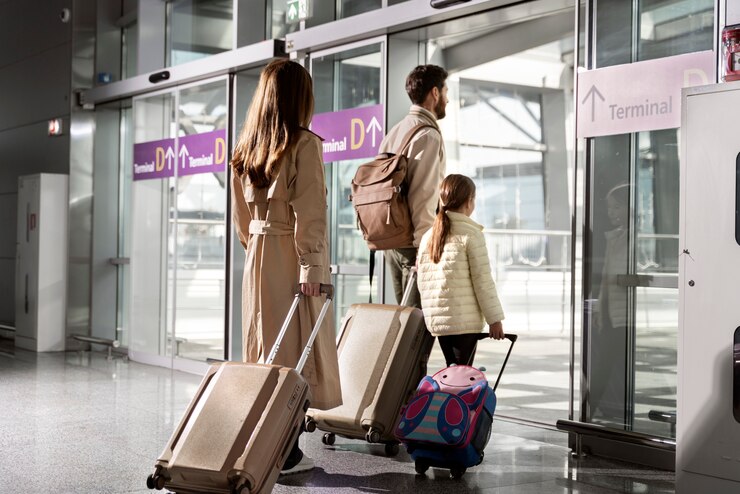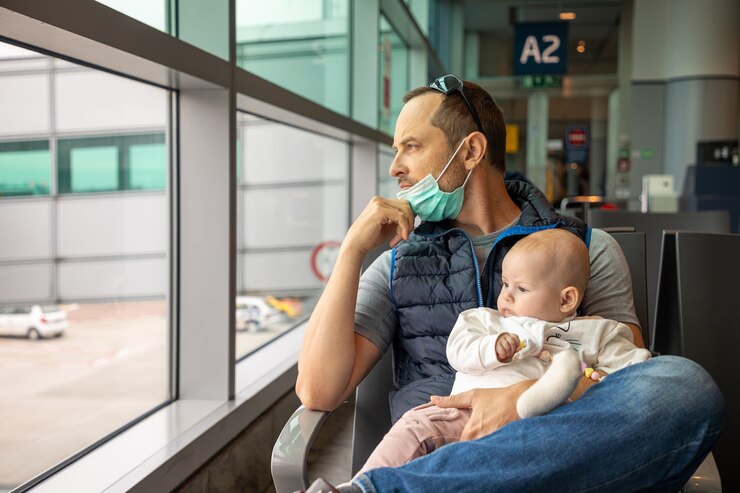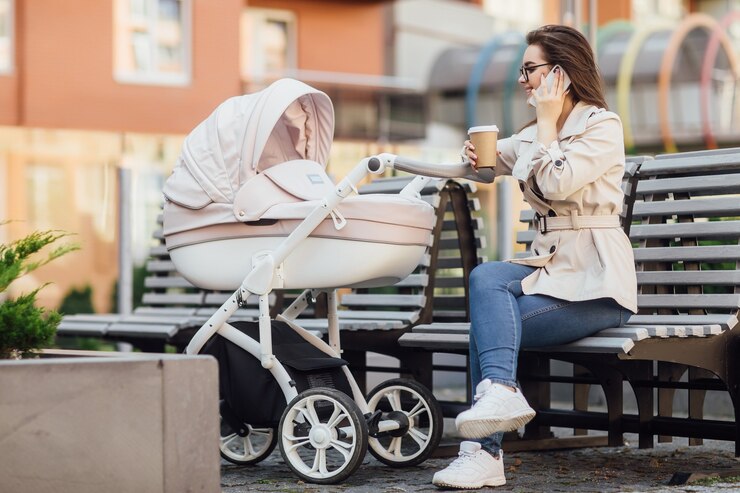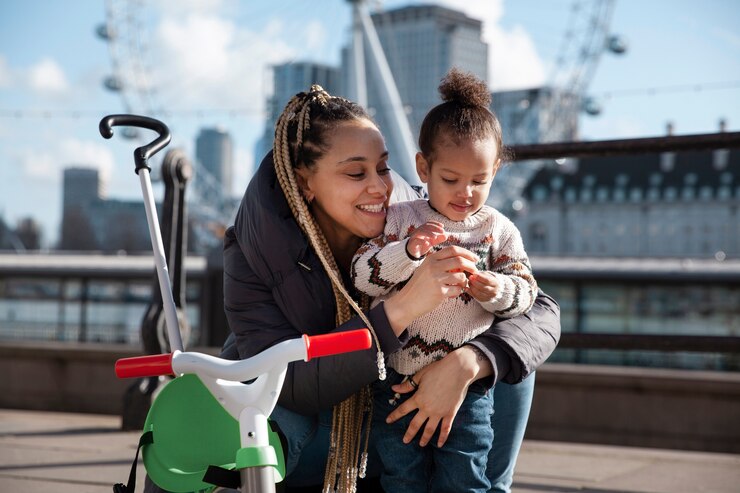International Travel With an Infant

Heading offshore with your beautiful new addition can be the most exciting and petrifying experience. Maybe you’re preparing road trips or domestic U.S. flights, or possibly international travel is in the near future — if so, consider that baby’s third (fourth?) month may be a useful starting point. During this phase, your baby can easily sleep through flights from a bassinet seat or nap in extremely comfortable style during car rides in a jogging stroller immediately. There are some important items of business you have to square away as soon-to-be first-time parents before flying off on your first adventure with your newborn, from the plane seat to baby gear reinforcements.
So when we enthusiastically booked a 3-week family adventure to South of France and Tuscany Italy with our first child, Caden, COVID hit us between the eyes. So we waited until Willow was 2 months old which just led to her writing another miserable Christmas that included more than one punch this time. Well, by that time, we had travelled quite a bit throughout the United States and even went to Mexico. Traveling is a new passion for our family and we have become quite experienced in international travel with baby, so here are some of my best tips and tricks for making the journey with an infant as manageable as possible.
And if the idea of flying with a baby for the first time stresses you — just remember to be prepared. It is a bit nerve wracking knowing its your first rodeo flying and going through airports with a baby but as you get more prepared the better confident you will feel.
Based on what we’ve done with our son from 7 weeks to 7 months, travel adapts well. Our youngest, Kaia, has been to 10 countries already on the world branch, for 15 flights (including 4 transatlantic), and stayed in approximately 20 hotels. Every trip has been an adventure and more challenging than the last as we navigated through different time zones, packed what types of ‘essentials’ in the suitcases that go under the plane, planned for and budgeted every expense so meticulously.
Traveling with a baby also means adjusting to the new normal, including perforated nights thanks time changes and saying no to some adults-only things. However, beautiful memories and cherished moments make all difficulties feel small. Soon enough your baby will grow too, a stowaway of sorts on all of your travels, and the experience you share as momma-pilot exploring the world with your tiny co-pilot may not be the easiest, but dammit is it rewarding.
When to Book Your Flights

On the other hand, an international trip with a newborn may sound stressful but figuring that all out ahead of time can make it feel more manageable. Plan your trip with the ideal dates when your baby will be 8 weeks old at the very least. The general rule of thumb is to wait until your baby is around 2 to 3 months old when her immune system has grown stronger, says Tanya Altmann, M.D., a spokesperson for the American Academy of Pediatrics and author of What to Feed Your Baby (American Academy of Pediatrics). Again, be sure to consult your doctor before you make any decisions.
On booking flights, go for Refundable! They can cost you a pretty penny, but they bring you and Mama some comfort in case the little one isn’t ready for international flights just yet. Depending on your life situation you may also want to purchase travel insurance.
Choose possible places in the plane where you can seat your baby. Most airlines will allow your babe to fly free on your lap but you might find it a more comfortable option with that little car seat. Be aware, however that you will indeed still have to let the airline know that there is a baby with you on your flight just as if he/she was on your lap.
Add a Lap Infant to Your Flight Reservation
Adding a Lap Infant to an International Flight: How & When That way your baby can be factored in — even if you’re planning to have her on your lap for the trip. You can do this when booking most airlines, or contact customer services after you have booked your own.
Note that lap child fees on international flights are also very common, but still usually a fraction of the cost for an adult. If you are seated in bulkhead seats, ask for a bassinet to make the flight less uncomfortable. Airplane, the cabin attendant will help to adjust after take off. Kids can sit anywhere where your party has gotten a seat — boarding early during family boarding will also give you some extra time to get those airplane seat arrangements sorted.
Also, keep in mind that most airlines will not allow two lap infants in the same row, so they may have to move you around if the seats are reserved incorrectly. Even still, DO NOT TRY TO BUCKLE IN YOUR LAP INFANTobviously — and instead request to use an empty seat for a car seat.
Tips & Tricks for International Travel with an Infant
While traveling with a new born baby could be an ecstatic encounter, but it might also have some challenges. When booking your flight, it is also crucial to keep this in mind — most airlines allow babies under 2 years old on a flight for free (with an adult). But if you are travelling to an international destination, adjunct cost of potentially 10% heading to the air fare and taxes is still applicable.
Just ask Kaia, who, at 7 months old, has already visited 10 countries and stayed in 20 hotels (in addition to taking a total of 15 flights), not to mention traveling across the Atlantic Ocean FOUR TIMES. Just remember to give the body time to adjust. Babies take a while to readjust to time changes, so expect some tough nights when jet lagging your children to another time zone. Expect the unexpected and be ready to adapt, especially if you are in a foreign country on top of a mountain-scramble up for some simple formula from a local bazaar — like in Anatolian heights of Oman.
The reality of traveling internationally with a baby, however, can also very unglamorous (just look at Instagram and you might see otherwise). Actually, it takes some forethought and dealing with the intricacies of eating in random cities (which sometimes means no-place for grown-ups) but always putting your baby first. Yes, your travels and accommodations may be hard, but trust me the memories you will make are worth it.
Be sure to pack extra checked bags when planning your air travel, carry bottles, and snuggle that little bundle of joy on the flight. If you end up getting tight connections, feel free to ask your fellow passengers who might be feeling the same way or even with a flight attendant. It takes a few outings but as your baby gets older and you get more experience with your new travel buddy, it starts to get easier.
Feeding Your Baby

If you are travelling out of the country with an infant, one important aspect of trip planning for new parents is about feeding your newborn baby during travel. Baby food, breast milk, and formula (may be pre-mixed or in powder) are considered medical necessitates by the TSA. This makes them not subject to the normal ounce restrictions that reflect regular drink and toiletry corrosion. But better be safe than sorry lest any trouble at the security check.
I flew with small containers of baby food (some pureed fruits) and pre-mixed formula without an issue. Remember, the TSA will have to check the bottles, so that might take a couple of extra moments for your security screening process but it’s usually over pretty fast. Carry empty sterilised bottles with you and fill them with formula during the flight by using water from in-flight service or drinking fountains.
In the event that you have to heat your baby’s food or formula some airports might have a microwave at a convenience store or baby care area with a breastfeeding recliner and changing tables. But obviously you cannot depend every airport having so many facilities. Have a back-up plan for nursing in privacy when quiet, and maybe bring some solids like cheerios or puffs! And don’t forget to pack some extra milk or formula in case of flight delays or tarmac times.
Baby Strollers

Strollers are excellent for travel with an infant. You literally walk with the stroller, gate check it and board. Some airlines, such as Southwest Airlines, have family boarding so you can get on early and fold the stroller away before going onto the plane. While not an obligatory purchase, a bag for stroller is definitely an accessory that can help to prevent your stroller from nicks and scratches.
A stroller is considered a personal item as it’s not included in what would be your allowed amount, but this can turn out to be quite an advantage as you can use the baby car seat for that matter and have some additional comfort (and familiarity) for your toddler during travel. You cannot bring your baby through the metal detector while they are in the stroller, however. If possible having your own car seat can be a great relief to know since it is something that your baby is use too. Even if you rent or buy a seat at your final destination, this will make everything easier for transporting your child.
For families looking to travel on the lighter side, the Baby Trend Snap N Go Universal Infant Car Seat Carrier is popular. Simple, collapsible and cheap, it’s an easy choice for your baby in transit. If you do opt to bring your every day travel system, think about weight – lighter possibilities will often be less difficult to get throughout the airport.
For a little extra security for all of your gear, you could pick up the padded bags from a company like J.L. Childress and they even offer them in a backpack style that makes carrying them a breeze. Remember to check your stroller or car seat at the gate, and make sure you get a tag at the desk — so you don’t have to scramble at the last minute. All of the blogs pointed to a travel stroller and, while our Uppa Baby Vista did take a bit of wear and tear traveling domestically, it was perfect with its bottom storage and many capabilities.
Take-Off and Landing

The most important goal of all when flying with an infant — a smooth take off and landing for your baby’s comfort. Be ready with a bottle, nurse or pacify your baby to help them avoid ear popping. On our initial short flights, I was especially concerned because my son did not want to use pacifiers. On one flight, he had polished off the entire bottle before take-off. This reduces the likelihood of your baby finishing before take off, and the rush at landing time.
Each flight might be a little bit different and while some babies seem unaffected by their ears on takeoff or landing, others may need some extra help to relieve the pressure. It turned out using the simple old bottle or nursing worked wonders, though we still tried to get him to take a pacifier when he woke up at all hours of the night.
It’s just an engineering marvel to see a huge aeroplane take off into the skies and, then land gently at its destination. It is an entirely miraculous system of engineering and flying talent from the time it takes off until it lands again. Knowing how to handle this times can make these moments less intimidating for you and your child. When you are preparing for your next travel, just keep in mind that while flying with a baby may seem daunting, then it comes to strategy — but do not consider that as an excuse for why you can’t travel, it can end up being such amazing fun experience both for you and the little one.








1 Comment
Pingback: Global Entry for Kids: What You Need to Know - New Modern Moms